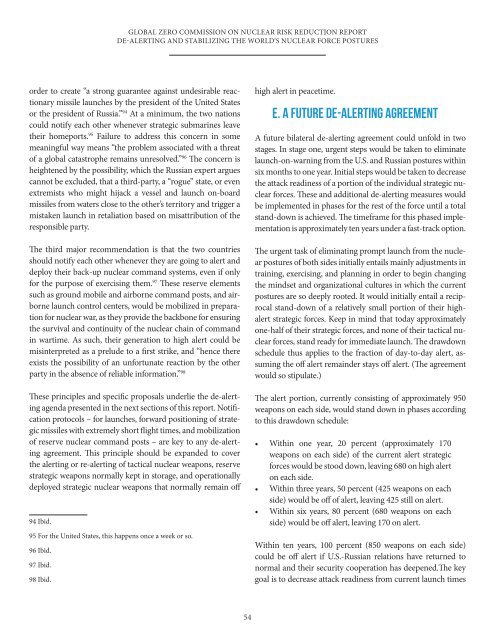global_zero_commission_on_nuclear_risk_reduction_report
global_zero_commission_on_nuclear_risk_reduction_report
global_zero_commission_on_nuclear_risk_reduction_report
You also want an ePaper? Increase the reach of your titles
YUMPU automatically turns print PDFs into web optimized ePapers that Google loves.
GLOBAL ZERO COMMISSION ON NUCLEAR RISK REDUCTION REPORTDE-ALERTING AND STABILIZING THE WORLD’S NUCLEAR FORCE POSTURESorder to create “a str<strong>on</strong>g guarantee against undesirable reacti<strong>on</strong>arymissile launches by the president of the United Statesor the president of Russia.” 94 At a minimum, the two nati<strong>on</strong>scould notify each other whenever strategic submarines leavetheir homeports. 95 Failure to address this c<strong>on</strong>cern in somemeaningful way means “the problem associated with a threatof a <str<strong>on</strong>g>global</str<strong>on</strong>g> catastrophe remains unresolved.” 96 The c<strong>on</strong>cern isheightened by the possibility, which the Russian expert arguescannot be excluded, that a third-party, a “rogue” state, or evenextremists who might hijack a vessel and launch <strong>on</strong>-boardmissiles from waters close to the other’s territory and trigger amistaken launch in retaliati<strong>on</strong> based <strong>on</strong> misattributi<strong>on</strong> of theresp<strong>on</strong>sible party.The third major recommendati<strong>on</strong> is that the two countriesshould notify each other whenever they are going to alert anddeploy their back-up <strong>nuclear</strong> command systems, even if <strong>on</strong>lyfor the purpose of exercising them. 97 These reserve elementssuch as ground mobile and airborne command posts, and airbornelaunch c<strong>on</strong>trol centers, would be mobilized in preparati<strong>on</strong>for <strong>nuclear</strong> war, as they provide the backb<strong>on</strong>e for ensuringthe survival and c<strong>on</strong>tinuity of the <strong>nuclear</strong> chain of commandin wartime. As such, their generati<strong>on</strong> to high alert could bemisinterpreted as a prelude to a first strike, and “hence thereexists the possibility of an unfortunate reacti<strong>on</strong> by the otherparty in the absence of reliable informati<strong>on</strong>.” 98These principles and specific proposals underlie the de-alertingagenda presented in the next secti<strong>on</strong>s of this <strong>report</strong>. Notificati<strong>on</strong>protocols – for launches, forward positi<strong>on</strong>ing of strategicmissiles with extremely short flight times, and mobilizati<strong>on</strong>of reserve <strong>nuclear</strong> command posts – are key to any de-alertingagreement. This principle should be expanded to coverthe alerting or re-alerting of tactical <strong>nuclear</strong> weap<strong>on</strong>s, reservestrategic weap<strong>on</strong>s normally kept in storage, and operati<strong>on</strong>allydeployed strategic <strong>nuclear</strong> weap<strong>on</strong>s that normally remain off94 Ibid.95 For the United States, this happens <strong>on</strong>ce a week or so.96 Ibid.97 Ibid.98 Ibid.high alert in peacetime.E. A FUTURE DE-ALERTING AGREEMENTA future bilateral de-alerting agreement could unfold in twostages. In stage <strong>on</strong>e, urgent steps would be taken to eliminatelaunch-<strong>on</strong>-warning from the U.S. and Russian postures withinsix m<strong>on</strong>ths to <strong>on</strong>e year. Initial steps would be taken to decreasethe attack readiness of a porti<strong>on</strong> of the individual strategic <strong>nuclear</strong>forces. These and additi<strong>on</strong>al de-alerting measures wouldbe implemented in phases for the rest of the force until a totalstand-down is achieved. The timeframe for this phased implementati<strong>on</strong>is approximately ten years under a fast-track opti<strong>on</strong>.The urgent task of eliminating prompt launch from the <strong>nuclear</strong>postures of both sides initially entails mainly adjustments intraining, exercising, and planning in order to begin changingthe mindset and organizati<strong>on</strong>al cultures in which the currentpostures are so deeply rooted. It would initially entail a reciprocalstand-down of a relatively small porti<strong>on</strong> of their highalertstrategic forces. Keep in mind that today approximately<strong>on</strong>e-half of their strategic forces, and n<strong>on</strong>e of their tactical <strong>nuclear</strong>forces, stand ready for immediate launch. The drawdownschedule thus applies to the fracti<strong>on</strong> of day-to-day alert, assumingthe off alert remainder stays off alert. (The agreementwould so stipulate.)The alert porti<strong>on</strong>, currently c<strong>on</strong>sisting of approximately 950weap<strong>on</strong>s <strong>on</strong> each side, would stand down in phases accordingto this drawdown schedule:• Within <strong>on</strong>e year, 20 percent (approximately 170weap<strong>on</strong>s <strong>on</strong> each side) of the current alert strategicforces would be stood down, leaving 680 <strong>on</strong> high alert<strong>on</strong> each side.• Within three years, 50 percent (425 weap<strong>on</strong>s <strong>on</strong> eachside) would be off of alert, leaving 425 still <strong>on</strong> alert.• Within six years, 80 percent (680 weap<strong>on</strong>s <strong>on</strong> eachside) would be off alert, leaving 170 <strong>on</strong> alert.Within ten years, 100 percent (850 weap<strong>on</strong>s <strong>on</strong> each side)could be off alert if U.S.-Russian relati<strong>on</strong>s have returned t<strong>on</strong>ormal and their security cooperati<strong>on</strong> has deepened.The keygoal is to decrease attack readiness from current launch times54


